The Travel & Tourism Competitiveness Report 2013
The Travel & Tourism Competitiveness Report 2013
The Travel & Tourism Competitiveness Report 2013
Create successful ePaper yourself
Turn your PDF publications into a flip-book with our unique Google optimized e-Paper software.
1.6: Competiveness, Jobs, and Green Growth<br />
Figure 2: A model for stakeholder engagement<br />
<strong>Travel</strong>ism demand<br />
Note: PPP = public-private partnership.<br />
Capacity building<br />
and green jobs<br />
Infrastructure, technology,<br />
and communications<br />
Brand marketing<br />
and e-distribution<br />
Economic growth,<br />
better livelihoods,<br />
and decent work<br />
<strong>The</strong> development of the green growth roadmap for<br />
tourism should enhance the long-term competitiveness<br />
of destinations and the supporting industries. It must<br />
be compatible with national travel, transport, tourism,<br />
and trade strategies as well as carbon commitments. It<br />
must ensure that socioeconomic growth is inclusive and<br />
provides decent jobs. Ultimately, it must bring about new<br />
demand and empower communities in the context of a<br />
broader balance sheet of societal well-being, including<br />
quality of life and environmental sustainability. In this<br />
context, carrying capacity and lifecycle analysis were<br />
pivotal. Overall, a green growth roadmap must deliver<br />
sustainable mobility, lifestyles, and communities.<br />
<strong>The</strong> report and underlying research framework have<br />
been specifically developed to serve as a readily adaptable<br />
model green growth 2050 roadmap for <strong>Travel</strong> & <strong>Tourism</strong><br />
(travelism) for any country, city, or community with a likeminded<br />
vision for green growth and travelism. It helps<br />
those who use the framework to:<br />
• respond effectively to a rapidly moving marketplace<br />
in very uncertain times;<br />
74 | <strong>The</strong> <strong>Travel</strong> & <strong>Tourism</strong> <strong>Competitiveness</strong> <strong>Report</strong> <strong>2013</strong><br />
Policy reforms, PPPs,<br />
finance, investment & innovation<br />
Gross national<br />
happiness<br />
Competitive<br />
advantage<br />
2050<br />
GREEN<br />
GROWTH<br />
VISION<br />
Sustainable<br />
destinations<br />
Sustainable<br />
lifestyles<br />
Low carbon and<br />
climate resilience<br />
Sustainable<br />
mobility Natural resources<br />
and waste management<br />
Product and<br />
destination management<br />
Empowered communities<br />
• engage travelism in a transformation to a lowcarbon,<br />
resource-efficient future;<br />
• thoroughly assess trends to improve<br />
competitiveness and the overall visitor economy;<br />
• handle increasing numbers of visitors and their<br />
impacts more sustainably;<br />
• integrate travelism into overall community<br />
development, focusing on local livelihoods;<br />
• engage local stakeholders and industry employees<br />
in the transformation;<br />
• access global education and training programs for<br />
capacity building in the sector;<br />
• consider new and traditional sources of funding to<br />
help with implementation; and<br />
• routinely review progress and adjust to both planned<br />
and unplanned changes.<br />
<strong>The</strong> framework allows any country, city, or<br />
community to consider these elements through an<br />
intensive scoping and visioning program that engages<br />
© <strong>2013</strong> World Economic Forum

















